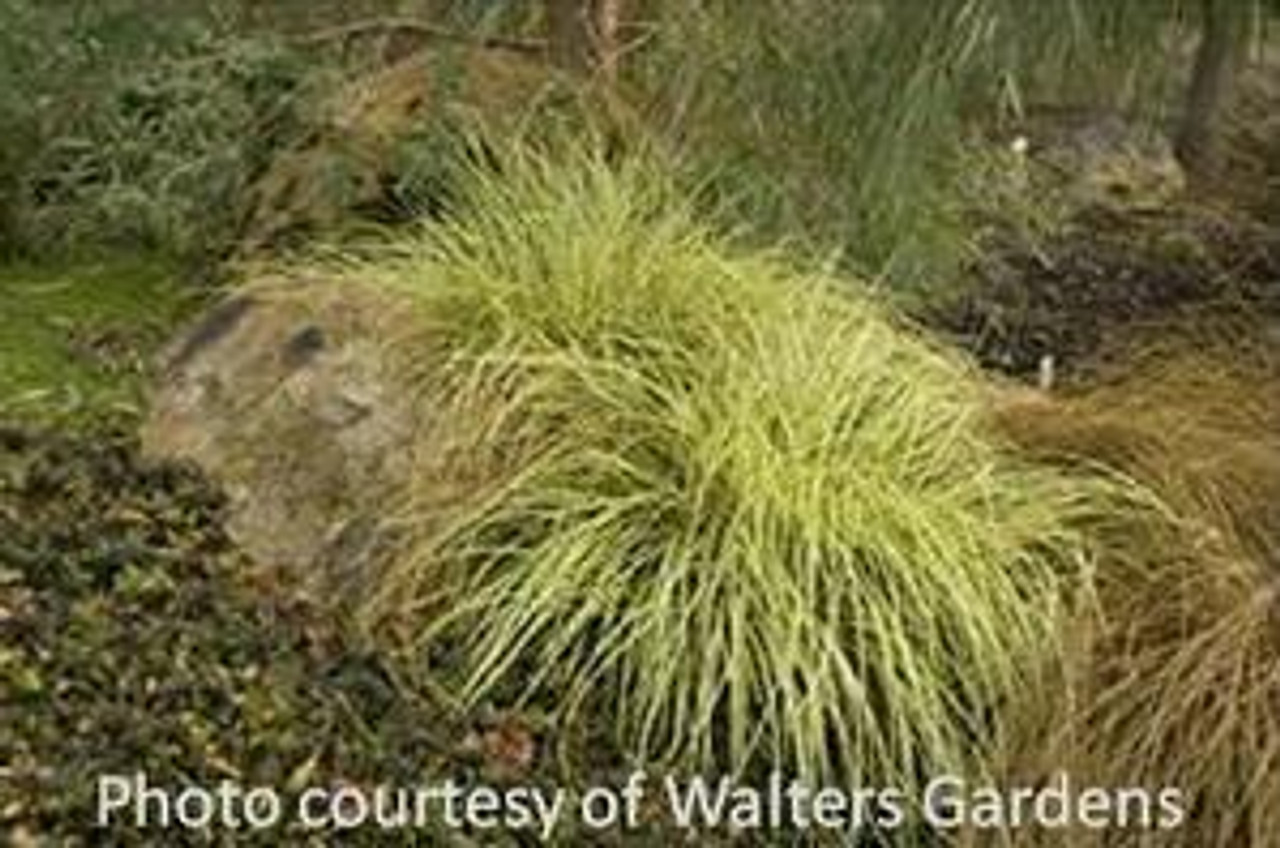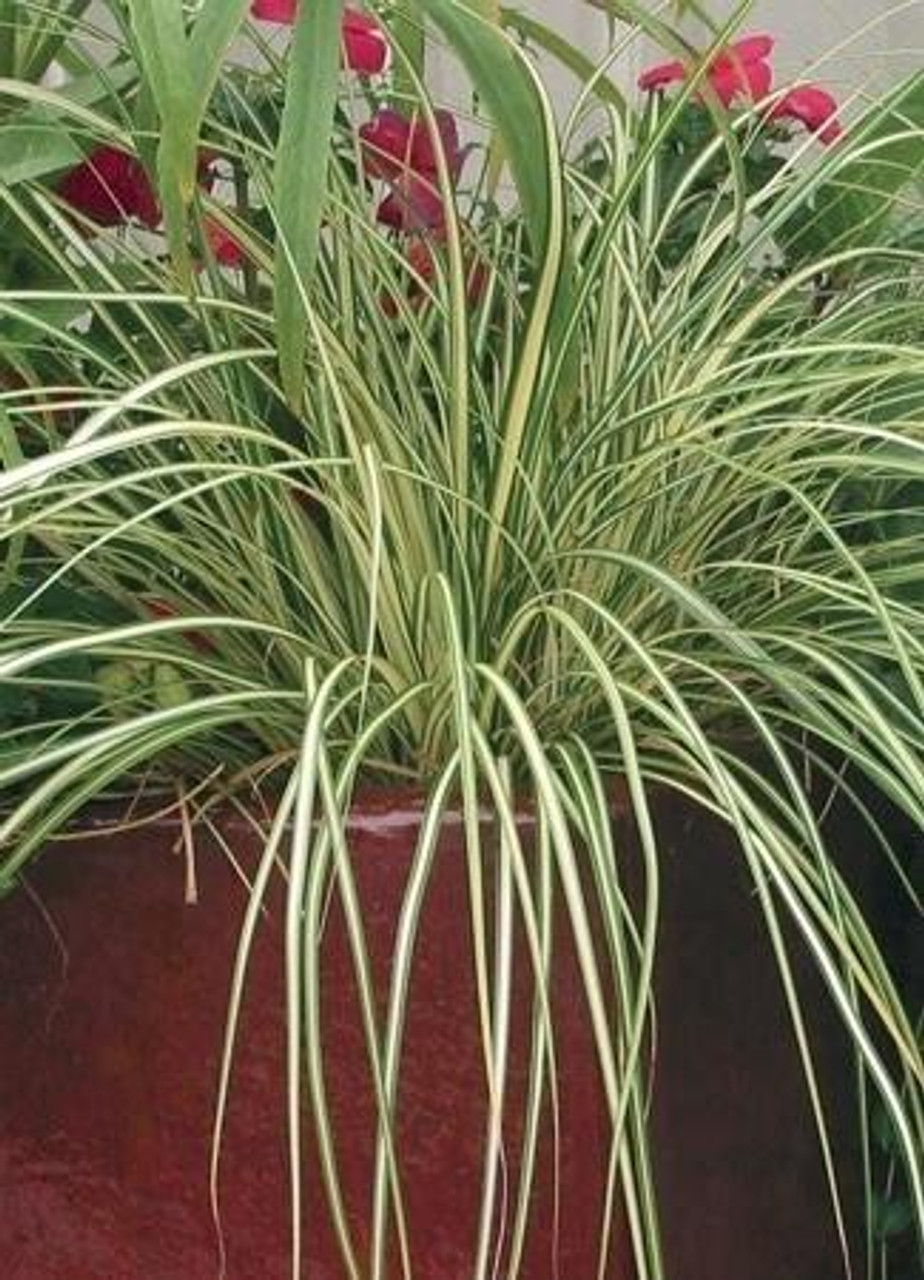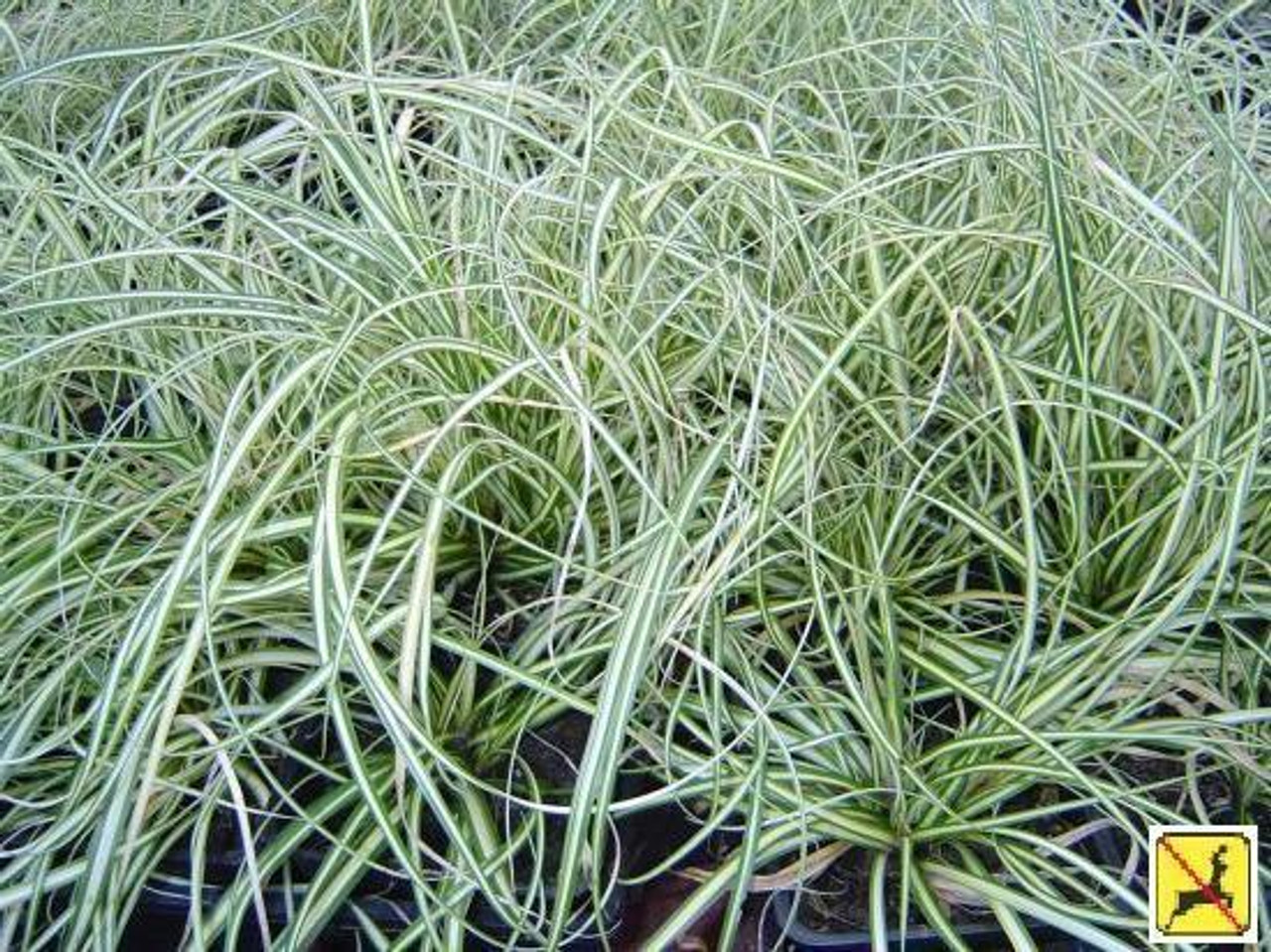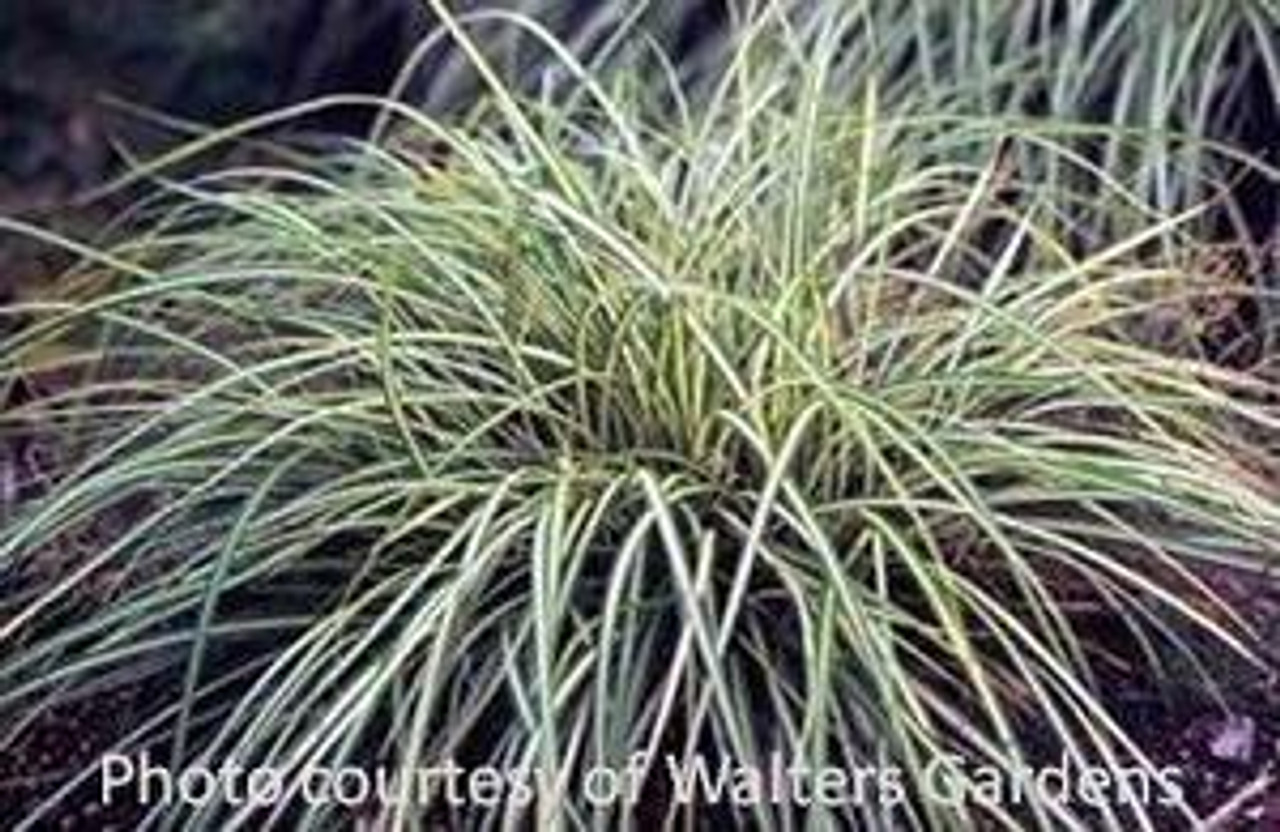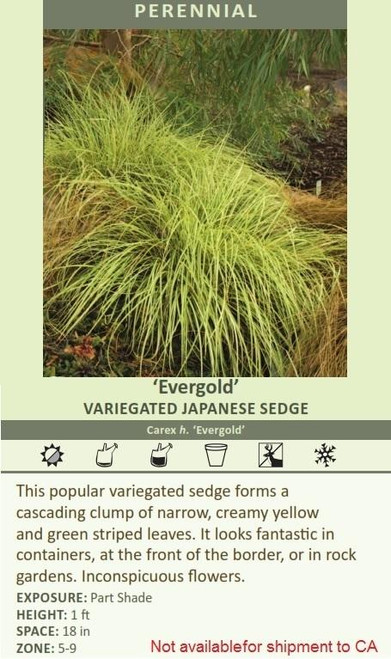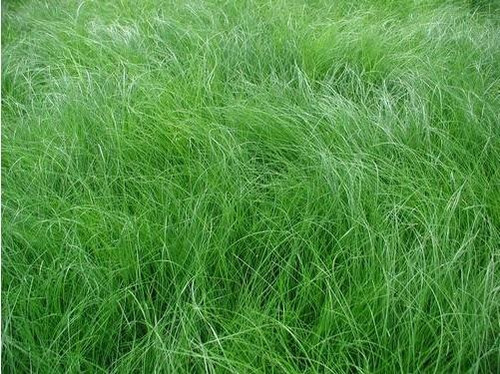Product Description
Carex oshimensis 'Evergold' (3.5-inch plant)
a/k/a Evergold Sedge, Sedge Grass, Variegated Japanese Sedge, Carex hachijoensis 'Evergold'
One of the most popular variegated sedges, this selection has creamy yellow leaves with dark green edges. They cascade softly to the ground in a fountain-like manner. Unlike many other sedges, this one prefers dry to average soil moisture. This versatile sedge is beautiful as a spiller in containers, rock gardens, and landscapes.
Evergreen leaves with creamy yellow variegated center strip with deep green margins. Coffee-colored flowers in spring. A cool-season growing that will maintain color through the summer. Cut back about 2/3 in very early spring. Foliage color is richer in part shade than in sun. Plants tend to languish in full shade. Plants thrive in moist soils, but also perform well in average garden soils, with better tolerance for periods of dryness than most sedges have. Plants generally dislike hot and humid summer climates.
Unlike many other sedges, 'Evergold' prefers dry to average soil moisture, well-drained, loamy, sandy or clay soil; but will tolerate damp soil conditions. In northern climates, it should be situated out of the way of winter winds. Good ground cover; use as a border plant; or in rock gardens, mass plantings, and containers. If plants look tattered in early spring, cut them back to the ground. The new foliage will quickly fill back in.
Royal Horticultural Society's Award of Garden Merit -- 1998
Zone 5 to 10,
Sun to part shade.
Mature foliage height 8 to 12 inches, clump forming.
Part Shade (4-6 hrs. Direct Sun)
Low to Average Water Needs
Average to Fertile Soil Quality
Deer Resistant
Evergreen
Growth Rate: Medium
Border Plant, Container, Edging, Ground Cover, Attractive Foliage, Small, Specimen, Focal Point
Carex oshimensis 'Evergold', also known as Evergold Sedge or Japanese Sedge 'Evergold', is a delightful ornamental grass that adds a touch of bright color and graceful texture to gardens. Here's a closer look at this charming plant:
Appearance:
- Foliage: 'Evergold' is prized for its variegated foliage. The narrow, arching leaves are a vibrant golden yellow with a thin, dark green margin. This striking color combination creates a beautiful contrast that brightens up shady areas.
- Growth Habit: This sedge forms a dense, mounding clump of foliage, typically reaching about 10-12 inches tall and 12-18 inches wide. The leaves have a graceful, weeping habit, creating a cascading effect.
Growing Conditions:
- Sunlight: 'Evergold' prefers partial shade but can tolerate full sun in cooler climates. It's an excellent choice for brightening up those shady corners of the garden.
- Soil: This sedge thrives in moist, well-drained soil. It's adaptable to various soil types, but good drainage is essential.
- Moisture: While it prefers moist soil, 'Evergold' can tolerate some drought once established.
- Hardiness: It is hardy in USDA Zones 5-9, making it suitable for a wide range of climates.
Special Features:
- Variegated Foliage: The bright golden foliage with dark green margins is the standout feature of 'Evergold', adding a touch of sunshine to shady gardens.
- Evergreen: In milder climates, 'Evergold' retains its foliage throughout the year, providing winter interest.
- Low Maintenance: Once established, 'Evergold' is a relatively low-maintenance plant, requiring minimal care.
- Deer Resistant: Deer tend to avoid this sedge, making it a good choice for gardens where deer are a problem.
Uses in the Garden:
- Shade Gardens: 'Evergold' is a perfect choice for shade gardens, where it can brighten up dark corners and add a touch of color.
- Borders: It can be used to edge borders or pathways, creating a delicate and natural-looking border.
- Woodland Gardens: It's a natural fit for woodland gardens, blending beautifully with other shade-loving plants.
- Rock Gardens: Its drought tolerance makes it suitable for rock gardens, adding a touch of soft texture to the hard edges.
- Containers: 'Evergold' can also be grown in containers, allowing you to enjoy its beauty on patios or balconies.
- Mass Plantings: Planting 'Evergold' in mass creates a stunning effect, with the golden foliage forming a sea of color.
Tips for Growing Carex oshimensis 'Evergold':
- Planting: Plant in spring or fall in a partially shaded location with moist, well-drained soil. Amend the soil with compost or other organic matter to improve its fertility and drainage.
- Watering: Water regularly during the first year to help the plant establish a strong root system. Once established, it's relatively drought-tolerant but will benefit from occasional watering during dry spells.
- Fertilizing: 'Evergold' doesn't require heavy fertilization. A light application of a balanced fertilizer in spring is usually sufficient.
- Dividing: Divide clumps every few years in spring or fall to rejuvenate plants and maintain their vigor.
Overall, Carex oshimensis 'Evergold' is a beautiful and versatile ornamental grass that adds a touch of bright color and graceful texture to the garden. Its adaptability to shade, low maintenance requirements, and deer resistance make it an excellent choice for gardeners of all levels.
Other Details
The most important part of the plant is its root system. Healthy roots are the foundation of a healthy, vibrant plant. The type of plug container used is based on the specific needs of the plants. Perennials offered as bare root traditionally perform better when planted as bare root.Planted in a specialized mix, potted plants have well established root systems. Top growth stage will vary depending on the current life cycle and time of year when shipped. In Winter and early Spring dormant plants may be shipped. Dormant plants may be planted right away, even before the last frost date.
Most bare root varieties are field grown for at least one season, though Hemerocallis and Hosta are grown for two seasons. The bulk of the soil is removed during the harvesting process and the tops of most varieties are trimmed back to the crown. They are graded, packed in shredded aspen or sphagnum moss and stored in freezers until ready to be shipped.
See our Container Sizes and Bare Root Perennials pages for more information.
Plant information and care is provided in the Overview section, Plant Genus Page and general information is provided in the Planting Care & Guides. Additional questions can be asked on each Plant page.
Plant Spacing: Using the maximum mature spread or width of a plant to guide spacing, ensures space to grow to full size. To fill an area sooner, plant them closer together. Just remember, future thinning or transplanting may be needed.
Water: Keep a close eye on newly planted perennials, especially throughout the first growing year. Most early plant loss is due to too much or too little water!
Product Videos
Custom Field
Product Reviews
3 Reviews Hide Reviews Show Reviews
-
Healthy plants grew well and look great.
Reasonable pricing, prompt delivery, a winner.
-
Carex Evergold
Shipped during very hot weather but it arrived in excellent condition. Very high quality plants of a nice size. I will purchase from here again!
-
Great response to a problem
Beautiful plants. We're using them to replace a bit of turf in a semi-shady area that wasn't doing well. We received our initial order in two boxes in early October. The plants in one box looked sick. We took a photo and emailed it to Bloomin. They responded immediately, sent us a replacement batch, diagnosed the sickly ones as having a non-harmful fungus, and advised us to cut them back. It's been 2 months now and the infected plants are bouncing back looking fine.


